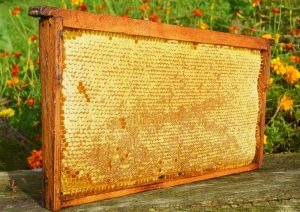The Raw Honey Factor – What You Need to Know June 29, 2017 – Posted in: Blog, Health

Honey is honey, right? Wrong!
Seventy-five percent of honey found at local supermarkets is not real honey. Whoa, say what? How can honey not be honey?
Believe it or not, there is black market honey on the shelves in the United States. 60% of imported honey (tens of millions of pounds of sticky golden goo) is Chinese honey that is ‘smuggled’ into the U.S. through other Asian countries. This so-called honey is void of all bee pollen. The foreign honey undergoes an ultra filtering procedure. Honey is heated to high temperatures, forcing the natural substance at high pressure through extremely small filters to remove pollen.
Honey stripped of pollen is, by definition, no longer honey.
Mark Jensen, president of the American Honey Producers Association, says that removing all pollen from honey “makes no sense.” He continues, “I don’t know of any US producer that would want to do that. [It] does nothing but cost money and diminish the quality of the honey.”
The only reason this costly and time consuming process is done is to mask the true origin of the honey. The removal of the pollen eliminates the only thing that can be used to identify its origin.
Further in-house tests done on supermarket honey reveals that fillers are often used in this ‘honey’. Imported honey has been found to contain high fructose corn syrup as well as other sweeteners.
What’s the big deal about honey anyway?
The United States is the world’s largest consumer of sweeteners, including high-fructose corn syrup.* According to the World Health Organization, the average American consumes more than 126 grams of sugar per day. This is more than 3 sodas per day. The copious amounts of sugar have literally fed the obesity epidemic in this country to reach an astounding 1 out of 3 people being defined as obese.
Let’s face it. Americans as a whole have a sweet tooth. Substituting high fructose corn syrup and other fructose containing syrups with organic, raw sugar isn’t the solution. These sweeteners trigger an insulin spike. Insulin causes your body’s cells to store fat.
Honey does not produce the high insulin spike that follows when you ingest sugar, also called sucrose, or other simple carbohydrates.
Honey is a nearly perfect 50-50 balance of fructose and glucose. These two sweeteners create a harmonious response in the body with the fructose turning on the insulin which results in the glucose being grabbed from the bloodstream and rapidly taken into the cells. With the fructose present, the glucose is stored as glycogen not fat! Glycogen is stored in the liver and used when needed by the brain, the heart, the kidneys, and red blood cells.
Honey also contains a list of other beneficial things. There are a small amount of other sugars, amino acids, phyto-nutrients (or plant nutrients), bioflavonoids, at least 16 antioxidants, small amounts of vitamins, organic acids, and some mineral elements. As an added bonus, the bee adds a few enzymes as well.
When you eat raw honey, you are consuming the best of the nutrients taken from the plant (less the fiber) and the body is immediately able to use it for food and energy.
So how do you know when to believe the label that’s on the bottle?
Sadly, the real truth is that you don’t know. We have a large hive and are preparing to install another one. I’m here to share some of what I’ve learned over the years about honey, bees, and nutrition. I can offer your some tips on what to look for when buying raw honey.
- Know your source for your honey
We will have our first harvest of honey from the new hive this year. While we wait to indulge in the fresh, backyard honey from our hive, I purchase honey from local honey farms. Where we live in Ohio, there are several neighbors who sell their honey. Take a look around your community or find a reliable source online from which you can order it.
- Read the label
Raw honey will include the words ‘raw’ and ‘unpasteurized’ on the label. Real raw honey has never been heated or processed. The heating process, also called pasteurization, is done to foods to kill off unwanted bacteria. Here’s the catch, honey is anti-bacterial by nature. Therefore, pasteurization of honey is not necessary.
In fact, pasteurizing honey makes it less healthy for you. The high heat required for the pasteurization process destroys the many healthy enzymes contained in the honey. It also damages the pollen and the propolis. Both of which have extremely beneficial properties when consumed.
Unpasteurized foods are OK for persons over the age of 1 year, but please consult your pediatrician prior to giving raw honey to an infant. Their tiny little guts haven’t developed enough to be able to fight off the toxins of the botulism bacteria that may be in honey.
- Raw honey is not 100% clear and perfectly golden in color
Real raw honey has a white layer on top of it and the honey itself is slightly cloudy or ‘milky’. If the honey is clear, so should you steer clear.
Honey, Do.
There is a long list of additional health benefits associated with using raw honey. Honey is more than a sweetener; it is a pure, natural food. If you haven’t already made the switch to raw honey, it’s time to reconsider its benefits over other sweeteners.
*https://www.ers.usda.gov/topics/crops/sugar-sweeteners.aspx

